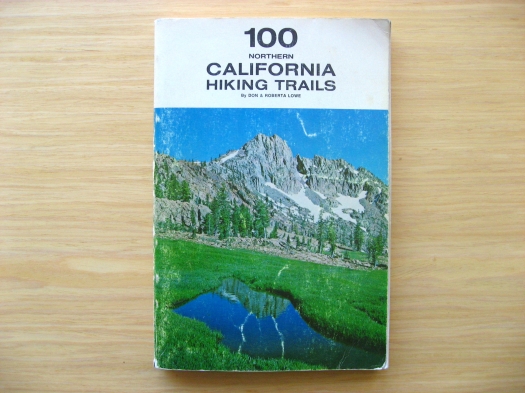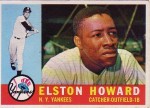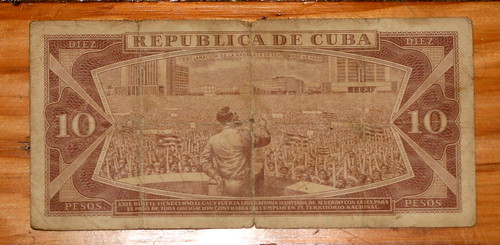Walking around the Maxwell Food Market near Singapore's Chinatown reminded of Wong Kar Wai's excellent movie about Hong Kong in the early 60's In the Mood for Love. After I watched it last night, I couldn't decide whether I wanted to actually travel back in time, or just walk inside an imagined version of the past. 


Category: the ancient past
Remembrances of things past, days of yore, olden times.
Their lives on the B‑list
Question: Is there a better litmus test of 1980's celebrity than a guest appearance on Love Boat? Wikipedia's master list includes Corey Feldman, Pat Morita, Rich Little, Menudo, the Village People, and the Pointer Sisters. Also included: Lorne Greene, Shecky Green, Pam Grier, and Andy Warhol. Surprisingly omitted: The Harlem Globetrotters.
Say what you will about the Soviets, but you can't argue with this reasoning for sending dogs, rather than monkeys, into space. If there's one universal truth of dogs, it is that they are "suited to endure long periods of inactivity." Lynne brought the subject of these Soviet cosmonaut dog-heroes to my attention, including those pictured at right — Belka (which "most likely means 'Whitey,'" according to Wikipedia's "Soviet space dogs" entry) and Strelka ("Arrow"). They were the first animals to go into orbit and return alive, spending August 19, 1960 in space before returning to Earth. Wikipedia helpfully adds that they were accompanied by some friends from the animal kingdom: "a grey rabbit, 42 mice, 2 rats, flies and a number of plants and fungi." All passengers survived.(Thanks to Dan Mogford, who grabbed the image off a commemorative Soviet matchbox).
Updike

I love writing letters, but for some reason the only letter-to-the-editor I've ever written went something like this:
Dear Mr. Remnick, If you publish one more story by John Updike, so help me God I will cancel my subscription immediately.Sincerely, Doug LeMoine
The year was 1999. I had been driven to what I saw as the brink — of patience! of sanity! — by the New Yorker's incessant publishing of Updike's fiction, which seemed (to me) not only incessant, but over-stylized, nauseatingly East Coast-ish, maudlin, wooden. No matter my mood, I found it insufferable and insulting, tone-deaf when it came to anything but older white guys. I don't like to speak ill of the departed, so I'll stop there and I'll admit that I've softened in the meantime. Updike's literary criticism is — who can argue? — instructive and insightful. He knew his stuff, and I felt enriched (sometimes grudgingly so) when I read his reviews. With regard to the aforementioned letter, my hand was forced almost immediately. Updike had published something like 25,000 stories in the New Yorker to that point, so I might as well have told John Henry to stop driving steel, or for Jerry Garcia to stop jamming. By the time my letter was fluttering into David Remnick's trashcan, I was already being forced to make good on my threat, a task that was ultimately embarrassing in its cold, bureaucratic execution. Contrary to any engaged reader's conception of the publisher-reader relationship, when you say "I'd like to cancel my subscription," they don't transfer you to the desk of the editor so that you can ream him a new one. You hear a few keystrokes, and then get asked if there's anything else you need help with. Upon reflection, this experience was a life lesson in itself. Mr. Updike, I thank you, and I wish you well.
Last night, Mara and I were messing around with Google Maps, checking out giant Japanese buddhas from the air. [Check out this one in Kamakura, near Tokyo]. Then we decided to see what North Korea looked like, and we raced over the Pyongyang and suddenly found this crazy thing with a giant triangular shadow. What the?Turns out that it's the Ryugyong Hotel. It has 105 stories, and it is indeed shaped like an arrowhead, with a broad base that tapers steeply to a pointy top. The craziest thing: It was abandoned in the mid-80's, during construction; hence its moniker: the Hotel of Doom. (Apparently, North Korea had already sunk 2% of its GDP into it when they decided to pull the plug. Ouch.)Esquire calls it worst-designed building in the world, which seems a little harsh. Would the world's worst-designed building inspire this: An animated short presenting a sort of Blade-Runner-meets-Disney-meets-Shinjuku vision for how the Ryugyong will be adapted in the future? Actually, maybe it would.See it for yourself here.
Archaeology of UX Weeks past
It's kinda strange (and thrilling) to browse through the many alleyways and avenues of Flickr and suddenly unearth a photo of … yourself. Just now I came across this picture of myself and a shadowy figure, who I suspect is UX it-guy Jan Chipchase taken last summer during UX Week. My hazy recollection: We met and hung out during a late-night trek through the Mall to the Washington Monument, a epic walk that included UX Week speakers, the entire event staff, and the multi-talented Maggie Mason of Mighty Goods (and, more recently it seems, Mighty Junior), who recorded the journey here. We left late, got back *really* late, and somehow Jan looked none the worse for wear during his keynote the next morning; epic, indeed.
I stumbled upon a treasure trove of old outdoors books at Iconoclast Books in Ketchum, Idaho this weekend; this one's from 1970.
 If only hiking through sun cups like these was as serene and lovely as the photo implies. Also, the introductory text instructs Yosemite visitors, "DO NOT FEED, TEASE OR MOLEST THE BEARS." Noted.
If only hiking through sun cups like these was as serene and lovely as the photo implies. Also, the introductory text instructs Yosemite visitors, "DO NOT FEED, TEASE OR MOLEST THE BEARS." Noted.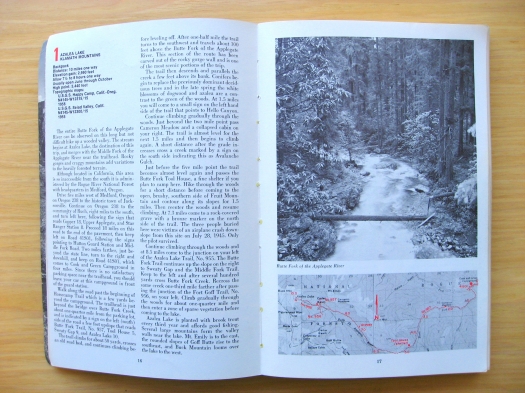 The page layout is classy, and the book is simple to navigate — each set of facing pages describes one hike. Also, the map is intended as a thumbnail overview, not as the actual guide for use during the hike. (In 1970, maps could be acquired by sending $0.50 to the USGS.)
The page layout is classy, and the book is simple to navigate — each set of facing pages describes one hike. Also, the map is intended as a thumbnail overview, not as the actual guide for use during the hike. (In 1970, maps could be acquired by sending $0.50 to the USGS.) How do you know which map to purchase from the USGS for $0.50? The relevant USGS map ID information is in the top left corner of each page! Each hike has a summary that contains all the important stuff — distance, elevation change, estimated time, and so on, ordered from most broad (and important) to most specific.
How do you know which map to purchase from the USGS for $0.50? The relevant USGS map ID information is in the top left corner of each page! Each hike has a summary that contains all the important stuff — distance, elevation change, estimated time, and so on, ordered from most broad (and important) to most specific.Cuban cashola
I traveled to Cuba 10 years ago this summer, and I unearthed this 10-peso note when I moved earlier this summer. Coincidence, or a sign that I should return sometime soon?
When I was there, the official exchange rate was one American dollar to one Cuban peso, but one could get 20 Cuban pesos with one American dollar if one exchanged money on the street. It appears that this hasn't changed, though Wikipedia notes that Cuban pesos have no value in currency markets. When I was there, Cuba was still reeling from the collapse of the USSR, and accommodations were made to handle the hardships known of this Special Period. For example, the American dollar could be used to purchase "luxury goods," though at that point "luxury" involved eating chicken once in a while and drinking an occasional beer. They've since introduced a second currency to replace the American dollar, the convertible peso, while keeping two tiers of goods. Yanqui go home!
This weekend I got an incredible book about San Francisco called San Francisco in Maps & Views. I usually avoid glossy coffee-table historical books because they're so often filled with disappointments — bad color, bad printing, messy layout, uninspired writing, PLUS they're really expensive. But THIS ONE. This one is different. The maps are very well-reproduced, high-res and colorful, and all are supported by detailed and surprisingly engaging commentary. After I got over the initial thrill of using it like a flip-book and watching my neighborhood evolve, I started to notice smaller trends in land-use evolution — a plot labeled "orphan asylum" became "hospital;" many things labeled "cemetary" became "park" or "civic center." "Dunes" become "the Sunset." I was also intrigued by the use of public places as refugee camps after the big one hit in 1906. Apparently, SF carpenters sprang into action and built thousands of makeshift cottages for the earthquake/fire refugees, turning many well-known SF public spaces into refugee camps, including South Park, Dolores Park, and Precita Park, and lots of the then-outlying, undeveloped areas, like the Richmond and the Sunset.
 A shack on Bikini Ridge would have been puh-retty sweet. (This is Dolores Park, believe it or not). Photo: Western Neighborhoods Project
A shack on Bikini Ridge would have been puh-retty sweet. (This is Dolores Park, believe it or not). Photo: Western Neighborhoods ProjectAs the city began to return to normal a year later, a few of the refugees decided to use the cottages — or, "shacks" as they were commonly known — as more permanent residences. Some industrious people combined multiple shacks into one residence. Incredibly, a few shacks are still around, and naturally folks have organized to preserve them. (Here's a 2002 Chronicle article about efforts to save some shacks in the outer Sunset).
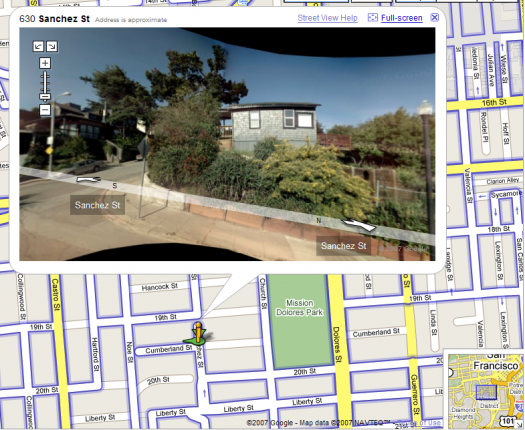 I believe that this is the house that is listed as 300 Cumberland on the Western Neighborhood Project's list of known shacks. The crazy thing is that this is at the top of an insanely steep hill, like un-bike-ably steep and long, so it must have been built there rather than transported from Dolores Park. On the other hand, who knows? People were crafty back then, right?
I believe that this is the house that is listed as 300 Cumberland on the Western Neighborhood Project's list of known shacks. The crazy thing is that this is at the top of an insanely steep hill, like un-bike-ably steep and long, so it must have been built there rather than transported from Dolores Park. On the other hand, who knows? People were crafty back then, right?Finally, here's a map of the locations of the known existing earthquake shacks. Seems like a good project for a weekend afternoon.



